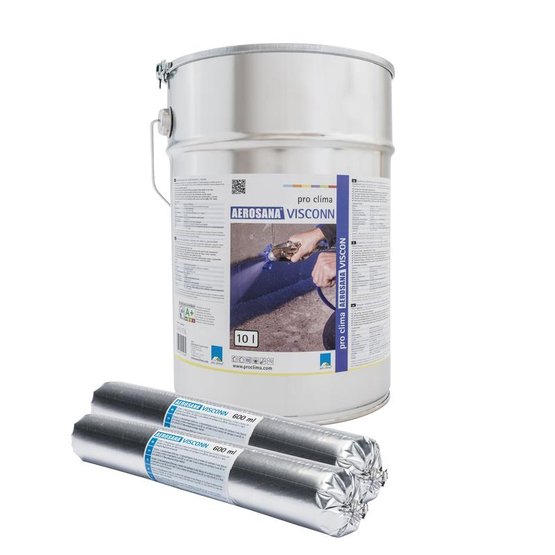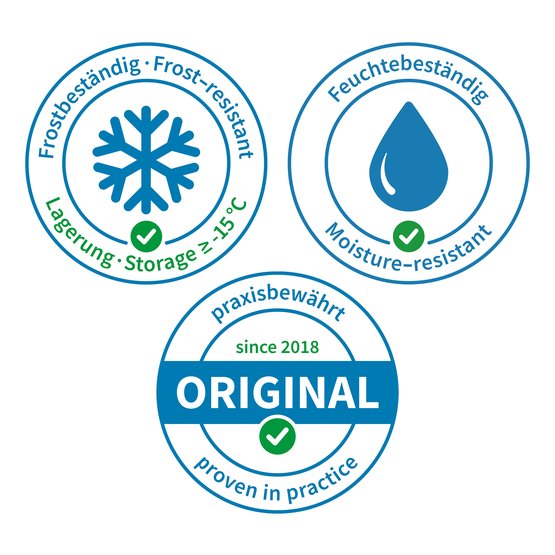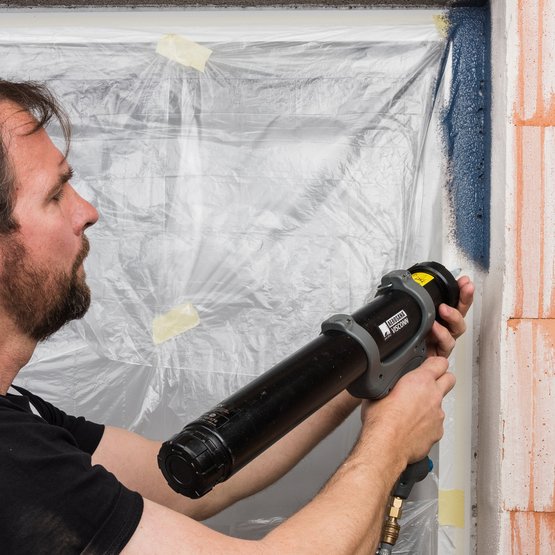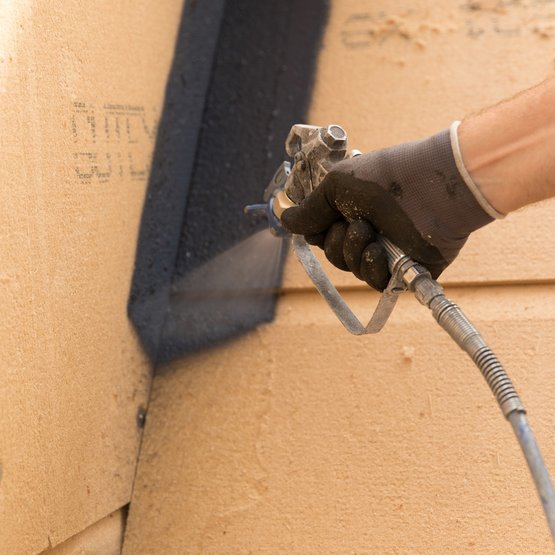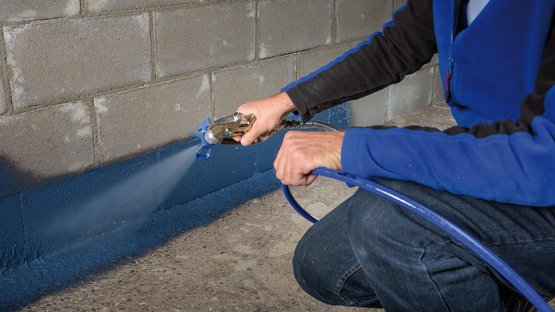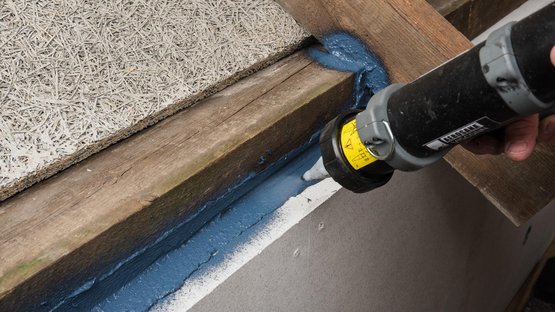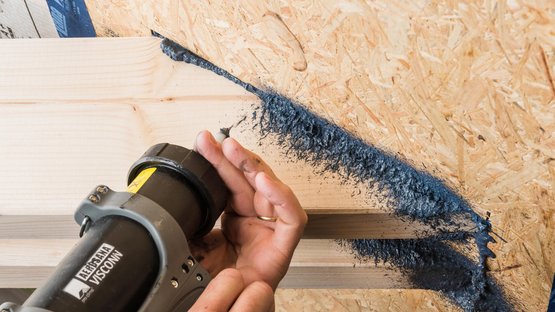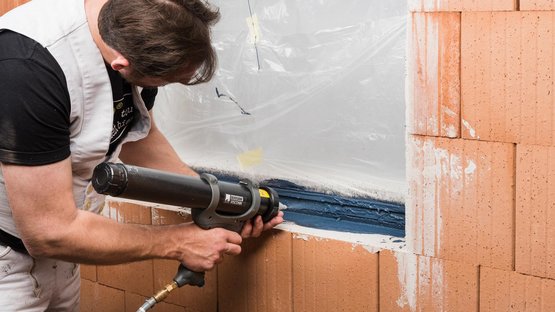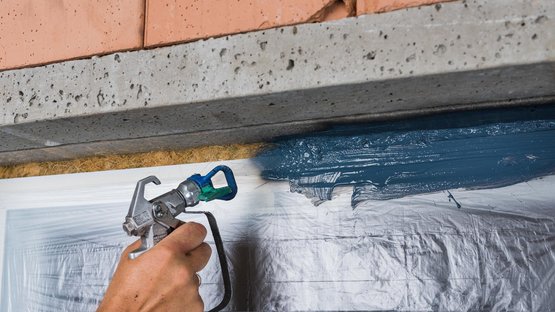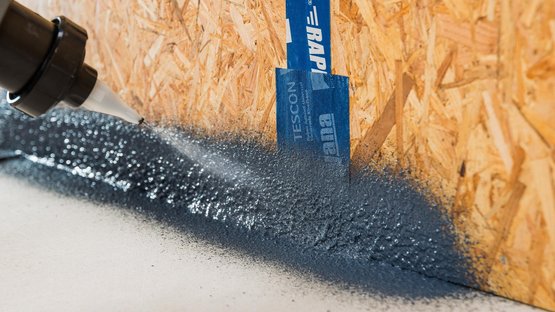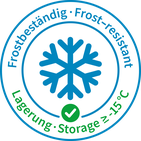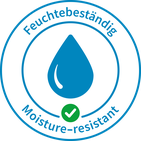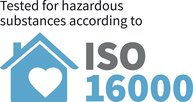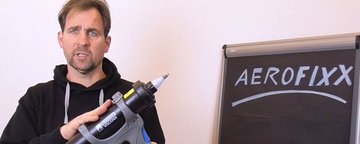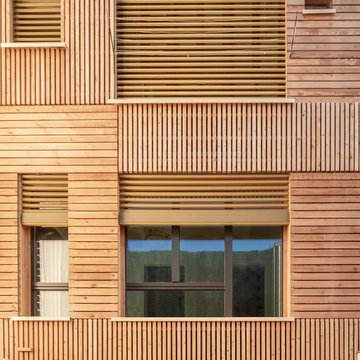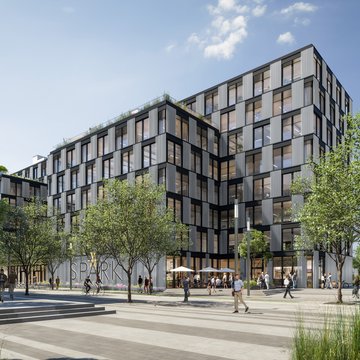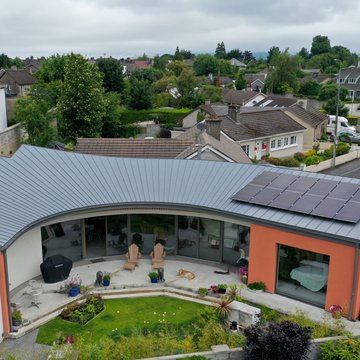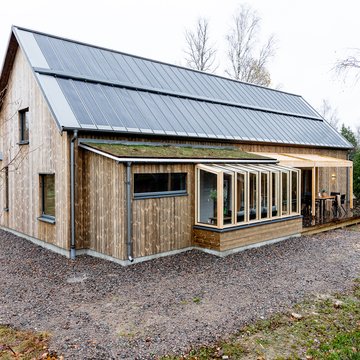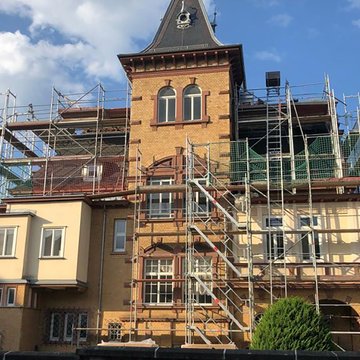Sprayable frost- and moisture-resistant sealant, humidity-variable, blue/black
Advantages
- Time-saving and can be applied in versatile ways: spray with an airless sprayer or AEROFIXX (compressed air) or else paint on
- Reliable structures thanks to excellent adhesive properties on all standard construction surfaces
- Covers cracks and joints of up to 3 mm (⅛”) width. Larger joints can also be covered in combination with AEROSANA FLEECE.
- Creates robust building structures: moisture-resistant, permanently elastic and highly durable once it has dried
- Improves surfaces: forms a bonding course between subsurfaces and subsequent coatings
- Can be plastered/painted over, and pro clima adhesive tapes can be applied over it
- Flexible use in indoor and protected outdoor areas thanks to its humidity-variable sd value
- Excellent values in hazardous substance testing, has been tested according to the ISO 16000 evaluation scheme
Areas of application
For use as a humidity-variable vapour control and airtightness layer that can be applied as a spray or using a brush on wall, ceiling and floor surfaces, such as non-plastered masonry or porous panel-form materials.
- Also for the creation of joints to components such as windows, roofs, walls, ceilings and floors, and for panel joints on airtight wood-based panels (e.g. OSB).
- Can also be used for strengthening subsurfaces on renovation projects.
- The humidity-variable diffusion resistance of this product means that it can be used on the interior and exterior of building structures.
- Forms a seamless, elastic airtight and vapour-controlling protective layer once it has dried.
Installation instructions
Video: Working with the AEROFIXX
Video: Sealing transitions at eaves with AEROFIXX on refurbishment projects
Video: Sealing around double collar ties with AEROFIXX
Video: Sealing around windows/doors with AEROFIXX
General conditions
Cracks that are wider than 3 mm (⅛”) must be taped over, covered with AEROSANA FLEECE or filled in with a suitable filler. Spraying should be carried out at a distance of approx. 15 cm (8”) from the subsurface.
Application in a number of layers can be carried out without any need for drying periods between them. Perfect airtightness can only be achieved with a complete AEROSANA VISCONN film with no gaps.
Linear joints: The best coverage is achieved when spraying is carried out in two layers. The spraying jet should be at approx. 60° to the subsurface, spraying away from the installer. The second spraying step should then be carried out in the opposite direction.
Sealing of surface areas: The best coverage is achieved when one layer is first sprayed on horizontally and then sprayed over vertically in a cross pattern.
AEROFIXX application
The AEROFIXX device is connected to a compressor with a suction flow rate of >300 l/min. The pressure should be set to 6 bar (87 psi). All AEROSANA VISCONN variants in 600 ml (20.3 US fl oz) foil cartridges can be applied using the AEROFIXX device. You can easily switch between line (bead) application and spray application by turning the spray head.
Airless application
Airless diaphragm or piston pumps can be used. The throughput of this equipment should not be less than 1.8 litres/min (60 US fl oz/min). The recommended nozzles for surface application are: 317 to 521 – for detail features: 210. The first digit of the nozzle designation specifies the spray angle in degrees (x 10°), the second and third digits represent the diameter of the nozzle in 0.0xx inches.
The pressure is set to ensure a uniform spray finish that is free of streaks. If streaks are visible beside the spray area, increase the spray pressure. If this does not help, clean or replace the filter. The optimal pressure is around 80-150 bar (1200 – 2200 psi), depending on the nozzle used. A mesh size of 60 is recommended for the pistol filter.
Stir the material slowly and uniformly before spraying it. Flush the airless device once with clear water and then empty it fully before putting it into service.
AEROSANA VISCONN FIBRE and AEROSANA VISCONN FIBRE white cannot be applied using airless sprayers; in this case, use the AEROFIXX application gun.
Layer thickness and drying
The required minimum layer thickness of 500 μm (20 mils) has been achieved when a seamless, slightly wavy surface (‘orange peel’) is formed on the surface of AEROSANA VISCONN during the spraying process. Cracks and pores in the subsurface must be covered or closed in order to achieve perfect airtightness. This can be done using AEROSANA VISCONN for cracks/pores up to 3 mm (⅛”), with AEROSANA VISCONN FIBRE up to 8 mm (⁵⁄₁₆”) by spraying or flooding.
The thickness should be checked using the measuring gauge at various points across the entire sprayed surface immediately after the last layer of AEROSANA VISCONN has been applied.
AEROSANA VISCONN changes colour from blue to black when it dries. AEROSANA VISCONN white does not change colour.
The moist film is to be protected against moisture (e.g. rain) until it has fully dried.
Immediately after the spraying work has been completed, the airless device is to be cleaned on the outside with water and flushed a number of times until the flushing water is no longer visibly turbid – completely remove any residues of AEROSANA VISCONN. For additional information (e.g. operating instructions), contact the manufacturer of the airless device.
Protective equipment
The air pressure raises airborne dust. For this reason, it is recommended that installers should wear personal protective equipment consisting of a mask, protective glasses and gloves, even in well-ventilated locations.
Application with a brush
All AEROSANA VISCONN variants can be applied using a brush. To ensure efficient working, the width of the brush should be ≥ 50 mm (2”). Check the minimum layer thickness of 500 μm (20 mils) using a measuring gauge.
Storage
If this product has been in storage for a longer period, water (~5%) can be mixed into it to achieve a consistency that is suitable for spraying. Do not dilute the sealant material too much (risk of excessive flow and poor coverage of cracks). Closing the container in an airtight manner and covering it with a thin sheet will help to prevent drying out.
Substrate
Before application, check whether the subsurface is suitable for a liquid film. It may be necessary to apply a number of coats in the case of uneven or textured subsurfaces. Gaps (pieces broken out of the subsurface) or significant unevenness may need to be closed using AEROSANA FLEECE, taped over before application (e.g. with one of the CONTEGA SOLIDO adhesive tapes, depending on requirements) or levelled off with filler.
Subsurfaces should be cleaned.
Application temperature should be above +5 °C (+40 °F) subsurface and air temperature. There must be no water-repellent substances (e.g. grease or silicone) on components to be coated. Subsurfaces must be sufficiently dry and stable.
Application is possible on moist, but not wet subsurfaces.
The liquid film adheres to all standard construction materials, e.g. mineral subsurfaces such as concrete and masonry (e.g. sand-lime bricks, other bricks, aerated concrete, pumice). Concrete or plaster subsurfaces may be sandy or crumbling to a small extent. Application is also possible to all pro clima membranes (SOLITEX ADHERO VISTO needs to be pre-treated with TESCON SPRIMER) and to membranes made of PE, PA, PP and aluminium, to unplaned, planed or painted wood, wood-based panels (chipboard, OSB, plywood, MDF and wood-fibre underlay panels), non-rusting metal subsurfaces and hard plastics (e.g. pipes, windows). AEROSANA VISCONN does not adhere to the TESCON RAPIC rapid-application adhesive tape. Cover TESCON RAPIC with a compatible adhesive tape (e.g. TESCON VANA) before applying liquid sealant.
Movement joints cannot be sealed due to the relative motion that can be expected. Transitions such as floor-wall joints are to be coated with the required minimum layer thickness (500 μm; 20 mils for wet application) along their entire lengths in the area to be sealed. Implement butt joints, such as valley areas for wood-fibre underlay panels, using AEROSANA FLEECE. If films (e.g. INTELLO) are to be sealed in an airtight manner, these should be stapled in place in the usual manner or else fixed in place using a suitable adhesive tape (e.g. TESCON VANA). The transition must be free of tension.
Protect adjacent materials/surfaces
Materials/surfaces beside the areas to be coated should be protected; this applies particularly to visible surfaces such as wood, glass, ceramics, clinker bricks, natural stone, paint/varnish and metal. Wash away any splashes immediately with copious amounts of water. Do not wait until they have hardened. Clean tools with water immediately after use. Collect the water used for washing and dispose of it in accordance with the locally applicable regulations - e.g. European waste code: 080416.
AEROFIXX technical support videos
Here you will find tips, support and troubleshooting information on how to work with AEROFIXX.



